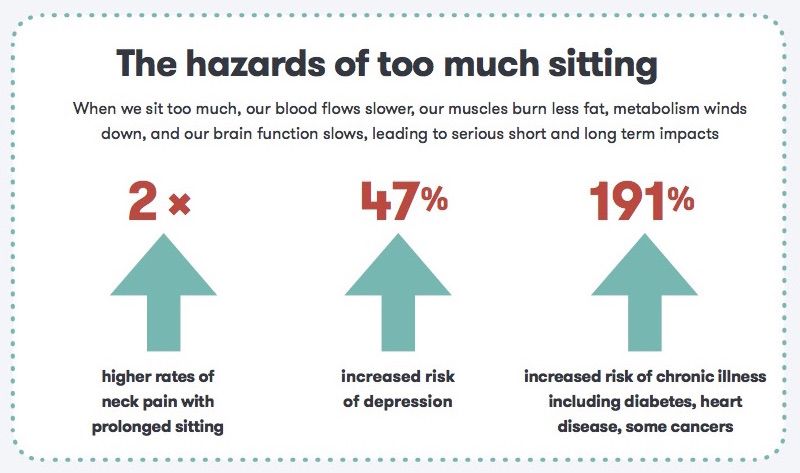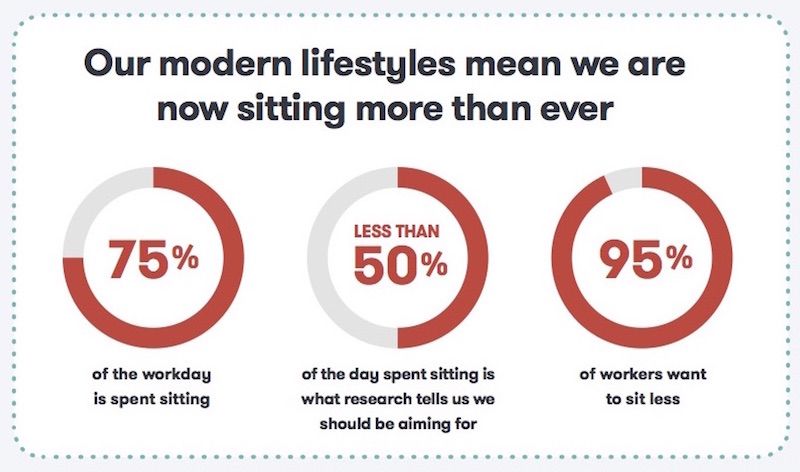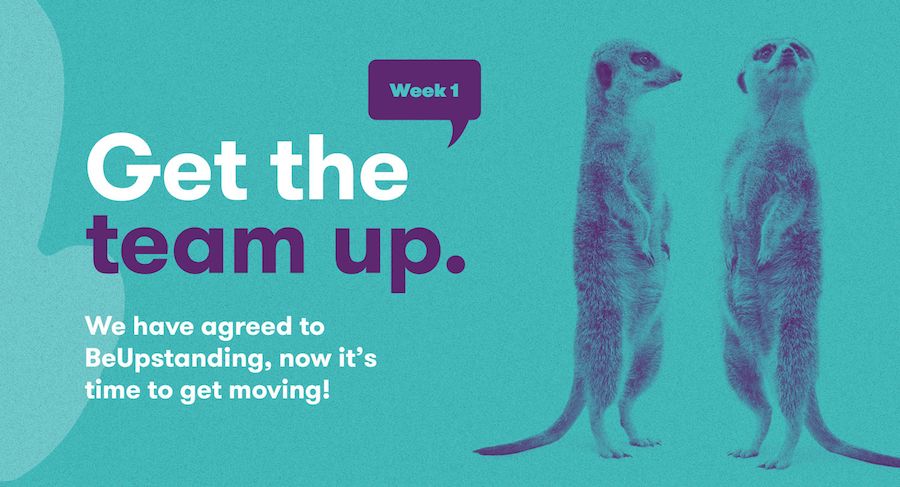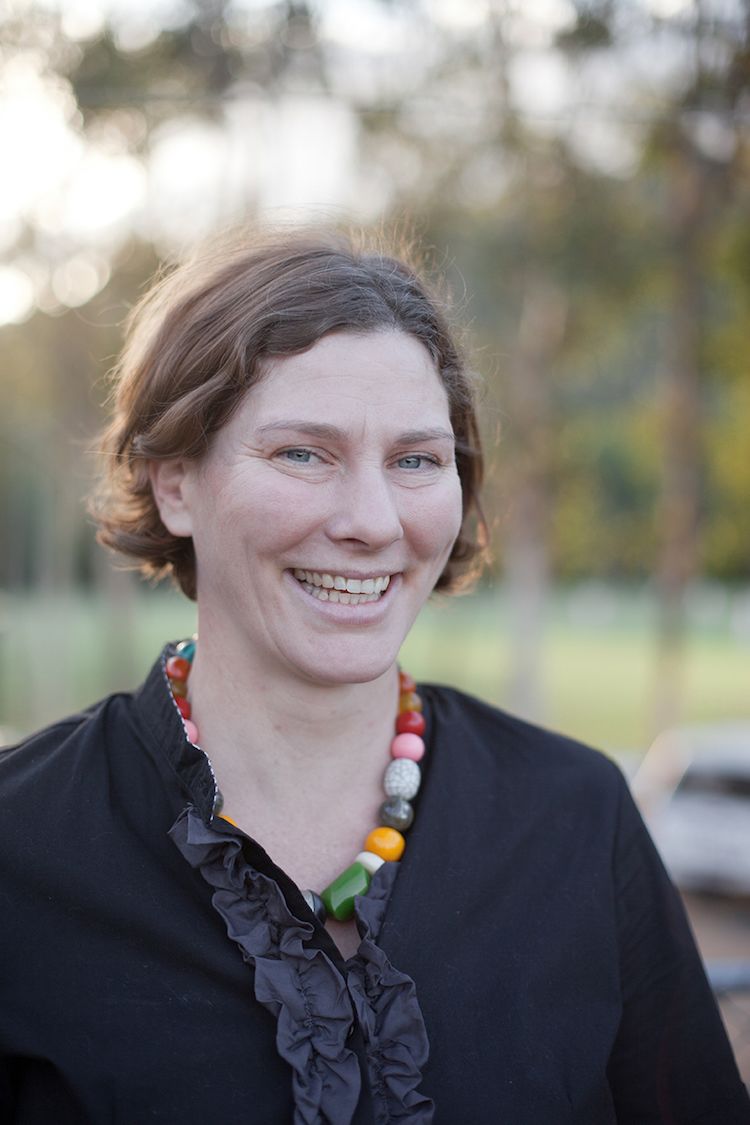Please be upstanding
UQ’s Associate Professor Genevieve Healy is helping workers combat the negative impacts of sitting for long periods of time by supporting them to stand up for their health.

No butts about it, our desire to take a load off at work and sit at our desks all day is affecting our health and wellbeing.
Research has linked sitting for long periods of time with an increased risk for diabetes, heart disease and even cancer. However, doing more exercise before or after work doesn’t necessarily cancel out your risk – the cure is to move more and sit less during the day.

“Increased modernisation and computerisation of tasks means that workers now sit more than ever before as part of their job roles,” Associate Professor Genevieve Healy says.
“We have monitored desk-based workers, and on average, they are sitting for 75 per cent of their work day.”

Over the past decade, Dr Healy from the School of Public Health, along with her colleagues at Baker Heart and Diabetes Institute, have been investigating the benefits of reducing and breaking up sitting time. This program of research has included large-scale observational studies, laboratory trials in at-risk populations, and nine interventions in a variety of desk-based workplaces to understand the benefits of reducing prolonged sitting times.
“Sitting less and moving more has benefits for both your physical and mental health and wellbeing,” she says.
“If you are doing regular exercise, and you have low levels of sitting, you are generally at the lowest risk of most chronic diseases.”
But that doesn’t mean we should be standing all day – in fact, this can also have a negative effect on our bodies, including putting stress on our lower back and affecting circulation.
The ideal solution for optimum health is a combination of sitting, standing and moving around. It sounds easy enough to do, but how many people make the effort to move more at work?

“The main barriers we’ve found are the way our workspaces are designed, our long-established sitting habits and the general office culture of sitting,” Dr Healy says.
However, Dr Healy, in collaboration with fellow UQ researcher Dr Ana Goode and other team members, is helping workers who typically sit for long periods of time stand up for their health with the BeUpstanding program.
Based on more than 10 years of research, the program is delivered through an online toolkit, and is designed to build a supportive culture in workplaces and make sitting less and moving more the norm.

The BeUpstanding program includes regular emails to participants
The BeUpstanding program includes regular emails to participants
“One of the key things we noticed in our research was the importance of workplace champions as the drivers and role models for the program,” she says.
“When designing BeUpstanding, we used a ‘train the champion’ approach – where the toolkit provides a step-by-step guide for a workplace champion to take up, deliver and evaluate the BeUpstanding program within their work team.
“It’s free and online so all a workplace champion needs is management approval to run the program. The actual strategies used to stand up, sit less, and move more are decided by the teams themselves, because after all, they know their workplace best.”
An introduction to the BeUpstanding Champion Toolkit
An introduction to the BeUpstanding Champion Toolkit
The BeUpstanding program is designed to be easy – with a step-by-step guide and multi-media resources, including videos and posters, to support the entire work team to get up and about. There’s also a blog that provides a hub to highlight the latest research findings, as well as hints and tips.
“It’s really about incorporating regular postural changes and more activity into our daily habits. We’ve found through our research that those regular breaks from sitting can have benefits for indicators of diabetes, heart disease and obesity.”
In Australia, one person is diagnosed with diabetes every five minutes, while cardiovascular disease kills one Australian every 12 minutes. By helping change the way people work, BeUpstanding is taking a step towards tackling these national health issues.
“We hope that the toolkit can become an effective and sustainable tool for workplaces to use to create a happier, healthier workplace where sitting less and moving more is the norm.”
Dr Healy and her team have been awarded NHMRC Partnership Project grant funding to conduct a national implementation trial of the toolkit. The BeUpstanding team are currently recruiting work teams to take part in this trial. If you are interested, please visit the website or contact the team at beupstanding@uq.edu.au to find out more.
If the trial goes well, Dr Healy hopes the project will continue to expand, perhaps even overseas.
“Obesity is a global epidemic with many countries around the world facing this growing problem, so ultimately we’d like to expand the program to an international audience, but we are taking it one step at a time.”
The story so far:
2005–2008: Genevieve Healy reported the first evidence that regularly breaking up sitting time was beneficial for heart health, during her PhD at UQ examining associations of physical activity and sedentary behaviour with blood glucose in Australian adults.
2009: Establishment of the Stand Up Australia program of research – a program led by the Baker Heart and Diabetes Institute and The University of Queensland in collaboration with government and non-government partners. This program, which now includes nine intervention trials and has produced more than 40 publications, aimed to understand the benefits of reducing prolonged sitting time in the workplace.
2011–2014: UQ were co-investigators on the NHMRC-funded Stand Up Victoria cluster-randomised controlled trial on reducing sitting time in office workers, led by Professor David Dunstan from the Baker Heart and Diabetes Institute.
2014–2018: UQ was one of the collaborating institutions on an NHMRC Centre of Research Excellence Funding on Sitting Time and Chronic Disease Prevention, led by Professor Neville Owen from the Baker Heart and Diabetes Institute.
2015–2016: Associate Professor Healy received funding from the Queensland Office of Industrial Relations to translate the Stand Up Victoria intervention into a low-cost/no-cost scalable program, BeUpstanding. The program, which is delivered through an online toolkit (The BeUpstanding Champion Toolkit), was then pilot tested.
2016–2017: The UQ team received further funding from the Queensland Office of Industrial Relations, as well as Safe Work Australia and Comcare to update and then test this optimised version of BeUpstanding in a soft launch.
2018–2021: The UQ team led a successful NHMRC Partnership Project grant funding to conduct a national implementation trial of the BeUpstanding program. The program is being promoted nationally through the five policy and practice partners: Safe Work Australia, Comcare, Queensland Office of Industrial Relations, VicHealth and Healthier Workplace WA.
(Images supplied by Associate Professor Genevieve Healy)

Contact details
Associate Professor Genevieve Healy, School of Public Health
Email: g.healy@sph.uq.edu.au
Phone: +61 7 336 55435
Web: researchers.uq.edu.au/researcher/757

Associate Professor Genevieve Healy
Associate Professor Genevieve Healy
